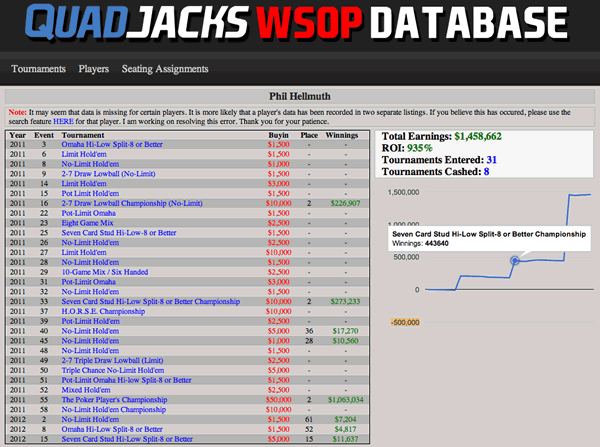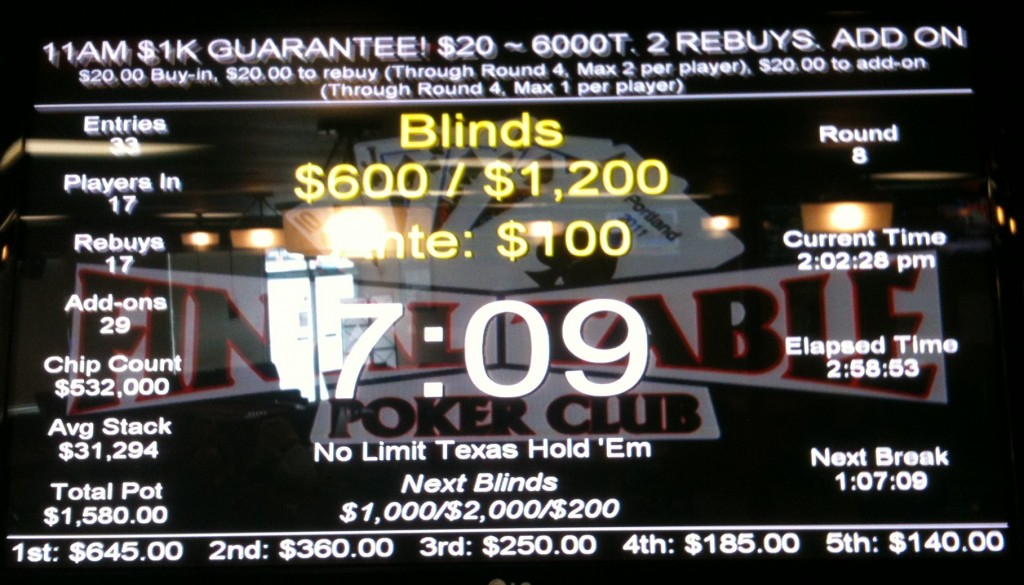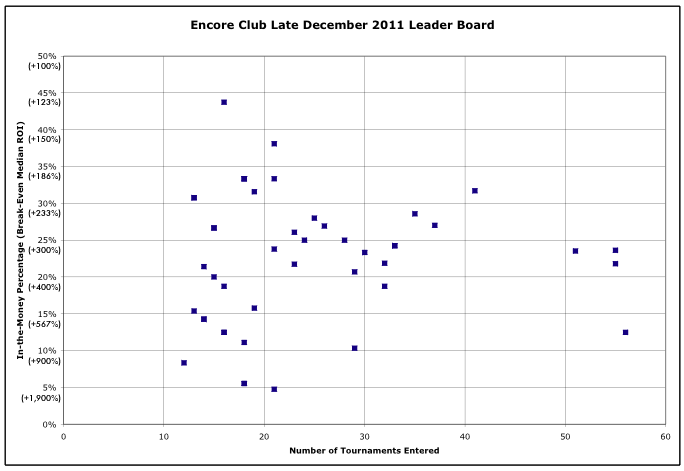Back in December’s “Why Not Rebuy?” article, I mentioned having trolled online tournament data to get an estimate of what the cashing percentage—more commonly referred to as in the money (ITM)—was for a good tournament player. Looking at the top ten players in a major PokerStars event ($10,300 buy-in) with 56,000 games between them, the ITMs were in the range of 13-17%.
Those kinds of statistics aren’t—so far as I’m aware—available anywhere for live tournament play. The venerable Hendon Mob poker database keeps fantastic records of poker cashes, but not all entries. Some interesting databases have come to my attention in the past couple of weeks, however, and I’d like to share what I’ve been able to glean from them.
WSOPdb.com has buy-in data gleaned from the PDF event lists posted on WSOP.com (available under the Reports tab for each event). It does a decent job of collating the data for each event and producing a list—searchable by player name—that shows entries for both 2011 and 2012, separated by year (events are automatically entered when the entrants list is available).
The Quad Jacks WSOP Database goes even farther, with a database searchable by event and player. Want to see the names of everyone who cashed in (or entered) the 2011 Event #5 Seven Card Stud competition? Want to see how much Phil Hellmuth has paid for buy-ins and how much he’s won this year and last? Easy-peasy.
Note: There are a few incongruities in both databases, which is only to be expected, considering that they’re generated by computer from documents that are themselves imperfect. There are some duplicate entries, there are some players with the same names and same home towns, there are players who listed (for whatever reasons) different home towns in different events, and players who cashed with no entries. I’ve tried to account for anomalies in the sample used for my analysis below.
You can see from the chart above that Hellmuth entered 28 events in 2011 and cashed five times (three of the listings and three of the cashes are from 2012). He was guaranteed to be cash-positive for the series after a second-place finish in the 2-7 Draw Lowball Championship, and his ITM for the series was 17.85%.
To determine a baseline for how well top players do in live tournament play, I decided to collate cashing and entry data from the Quad Jacks database (QJDB) and cross-check it with WSOPdb (I began my work before the 2012 WSOP began, which both were still undergoing some modifications, originally, I had to count the number of tournaments entered and cashed by hand).
My overall sample set consisted of every player who made the top nine in a 2011 WSOP event. Collation was done by “hand”, requiring a look at each of the 58 tournament pages in the QJDB and a count of cashes and wins from the player page for each of the top nine players in the tournament (unless the player was already in the database). This phase produced a list of 462 unique players who were in the top nine players of at least one event.
As a group, these 461 players entered 5,642 events and cashed in 1,059, for an aggregate ITM of 18.8%. The median ITM was 21.4%, however, because nearly a quarter of the players in the sample played fewer than five events. Players who managed to get to the final nine in an event usually made enough money that they could afford to buy their way into other tournaments or the Main Event, and many did. Even if they lost a chunk of their winnings (an eighth-place cash in a Limit Hold’em event might pay only about three times the buy-in for the Main Event), their ITM would be at least 25%.
I was mostly interested in statistics for top tournament players, folks who got lucky in a tournament or players moving up the tournament ladder who were making their annual stab at the WSOP with a smaller bankroll weren’t the “top of the field,” even if they were good players. To limit the sample set to only top players, I added another requirement: the player had to have entered 20 or more tournaments during the 2011 WSOP. This meant they needed to be successful enough to have a bankroll (or backing) that could absorb a minimum of $30,000 of entries (assuming all they entered were $1,000 and $1,500 events) and that they were serious enough players that they were at the WSOP for a minimum of three weeks.
97 players made the cut. It’s a group with famous names like Tom Dwan and Bertrand Grospellier in it (and infamous names like Allen Kessler). Maria Ho, Phil Collins, John Racener, Eli Elezra, Chris Moorman. They’re all there (although I believe Ho and Odette Tremblay, who took 9th in a $1,000 NLHE event, are the only women).
Although they’re just over 20% of the total number of players in the original sample, the 97 players with twenty or more entries played a combined total of 2,521 tournaments, nearly 45% of all the tournament entries for the complete sample. They cashed a combined 332 times, for an ITM of 13.2%, and the median ITM was 13.6%.
Why look at an aggregate value rather than individual statistics? It’s well-known that tournament play is notoriously variable. Players can do phenomenally well one year and brick out the next. Raw numbers can be incredibly deceptive, as well. The two players at the top of the list in sheer volume of events entered are George Lind (2/39, ITM: 5.1%) and Justin Smith (2/40, ITM: 5.0%). Lind played in the pricey ($25,000) Heads-Up NLHE tournament to start with and didn’t have any luck until Event #11, when he took second in an the $10,000 Omaha 8 Championship for $287,554. He spent another $130,000 on entries between that win and Event #55, the $50,000 Poker Players Championship, when he scored big again with a sixth-place finish for $300,441, ending up about $345,000 in the black for the series. Smith, on the other hand, with exactly the same ITM as Lind, didn’t have a profitable series. The number of events he played meant that he was in many of the same games Lind was in, so his outlay was similar, but his two cashes were a sixth-place in the $10,000 Limit HE ($71,897) and 116th in a $1,500 NLHE event (only $3,684), so he ended the series with a loss of over $166,000. So I feel it would be a mistake to make assumptions based on a single player—or even a small group of players—who had cashed in the WSOP.
The criteria I have established for this sample: players who have reached the top rungs of their peer group at least once by making what is essentially the final table of an event at least once and who have been tested repeatedly against the best of their peers by entering more than a third of the events at the poker world’s premier contest, should be rigorous enough for us to make some generalizations about the group, however. First, it should be pointed out that having a tournament ITM in the range of the top players in the world doesn’t necessarily make you profitable. If you’re spending a significant portion of your winnings from one tournament on the buy-in for a larger tournament, then your tournament play by itself probably isn’t profitable. A number of the players on the list fall into that category. They might have made up for losses in the WSOP during the year by other tournaments or cash play, but the series itself was a loser. In fact, of the 97 players in the study group, 40 booked losses for the series despite having one or more cashes. Of the 57 players in the group who finished the series in the black, most of them (33) were profitable only because of their largest win; Take it away and they fall into a hole of red ink. Two players were profitable, but just barely, in the black for probably (far) less than their expenses for food and/or accommodation.
One trend that was obvious throughout the work I did to collate this data was the influence of large buy-in events like The Poker Players Championship ($50,000), the Heads-Up Championship ($25,000), and the ten $10,000 Championship events culminating in the Main Event. Many of the players on the losing side of the study would have been in the black (or at least a lot closer to even) had they not played several of those events. Doubtless, many of them could afford to, because they could make up the money elsewhere, but it looking through the individual player statistics does provide an object lesson in bankroll management for those of us inclined to take a shot at a big game. Over and over.
A final note: These are only players who entered twenty or more events and made the top nine positions in an event. Undoubtedly, there are many more players who entered twenty events and had profitable years without making the top nine of an event (72nd place in the Main Event paid more than first place in the $1,500 2-7 Draw Lowball event). There are undoubtedly players who lost more than the players in the sample, as well, not having gotten one of the top prizes in an event during the year. But I think this group provides as good a look into the statistics of top poker players as I’m likely to get without access to the entire WSOP database.
Below is the sample of players who entered 20 or more events during the 2011 WSOP and placed in the top nine positions of at least one event, sorted by the number of events entered and the number of cashes.
| Player Name | Entries | Cashes | ITM |
| Justin Smith | 40 | 2 | 5.0% |
| George Lind | 39 | 2 | 5.1% |
| Roland Israelashvili | 38 | 6 | 15.8% |
| Jason Mercier | 38 | 5 | 13.2% |
| Tom Dwan | 37 | 3 | 8.1% |
| Michael Mizrachi | 37 | 1 | 2.7% |
| David Benyamine | 37 | 1 | 2.7% |
| Ali Eslami | 35 | 5 | 14.3% |
| Stephen Chidwick | 35 | 4 | 11.4% |
| Phil Laak | 35 | 3 | 8.6% |
| Bill Chen | 35 | 3 | 8.6% |
| Scott Clements | 33 | 3 | 9.1% |
| David ‘Bakes’ Baker | 32 | 4 | 12.5% |
| Jacobo Fernandez | 31 | 4 | 12.9% |
| Dan Kelly | 30 | 5 | 16.7% |
| Nick Binger | 30 | 3 | 10.0% |
| Fabrice Soulier | 30 | 1 | 3.3% |
| David Chiu | 29 | 5 | 17.2% |
| Justin Bonomo | 29 | 4 | 13.8% |
| Bertrand Grospellier | 29 | 4 | 13.8% |
| Alexander Kuzmin | 29 | 3 | 10.3% |
| Eric Cajelais | 29 | 1 | 3.4% |
| Shaun Deeb | 28 | 6 | 21.4% |
| Phil Hellmuth | 28 | 5 | 17.9% |
| David Sands | 28 | 5 | 17.9% |
| Issac Haxton | 28 | 4 | 14.3% |
| Chad Brown | 28 | 3 | 10.7% |
| Daniel Makowsky | 28 | 3 | 10.7% |
| Mclean Karr | 28 | 1 | 3.6% |
| Brent Hanks | 27 | 5 | 18.5% |
| Scott Seiver | 27 | 4 | 14.8% |
| Matthew Smith | 27 | 4 | 14.8% |
| John Racener | 27 | 4 | 14.8% |
| Jeremy Ausmus | 27 | 4 | 14.8% |
| Allen Kessler | 27 | 3 | 11.1% |
| Chris Bjorin | 27 | 3 | 11.1% |
| Humberto Brenes | 27 | 3 | 11.1% |
| Phil Collins | 27 | 2 | 7.4% |
| Steve Billirakis | 27 | 2 | 7.4% |
| Gabriel Nassif | 26 | 6 | 23.1% |
| Barry Greenstein | 26 | 5 | 19.2% |
| Michael Binger | 26 | 4 | 15.4% |
| Joe Tehan | 26 | 4 | 15.4% |
| Andrey Zaichenko | 26 | 3 | 11.5% |
| Josh Brikis | 26 | 3 | 11.5% |
| Brandon Meyers | 26 | 2 | 7.7% |
| Jared Solomon | 26 | 1 | 3.8% |
| Matt Stout | 25 | 4 | 16.0% |
| Dario Alioto | 25 | 4 | 16.0% |
| Alexander Wice | 25 | 3 | 12.0% |
| Alexander Queen | 25 | 2 | 8.0% |
| Matt Glantz | 24 | 5 | 20.8% |
| Eli Elezra | 24 | 5 | 20.8% |
| David Baker | 24 | 5 | 20.8% |
| Josh Arieh | 24 | 5 | 20.8% |
| Vitaly Lunkin | 24 | 4 | 16.7% |
| Michael Benvenuti | 24 | 4 | 16.7% |
| Eugene Katchalov | 24 | 3 | 12.5% |
| Alexander Kostritsyn | 24 | 3 | 12.5% |
| Chris Tryba | 24 | 3 | 12.5% |
| Matthew Waxman | 24 | 3 | 12.5% |
| Maria Ho | 24 | 2 | 8.3% |
| Dan O’Brien | 23 | 6 | 26.1% |
| Victor Ramdin | 23 | 6 | 26.1% |
| Samuel Stein | 23 | 5 | 21.7% |
| Christian Harder | 23 | 4 | 17.4% |
| Max Pescatori | 22 | 6 | 27.3% |
| Shawn Buchanan | 22 | 5 | 22.7% |
| David Bach | 22 | 4 | 18.2% |
| David Pham | 22 | 4 | 18.2% |
| Eric Froehlich | 22 | 3 | 13.6% |
| Brock Parker | 22 | 3 | 13.6% |
| Adam Kornuth | 22 | 2 | 9.1% |
| John Hennigan | 22 | 2 | 9.1% |
| Antonio Esfandiari | 22 | 1 | 4.5% |
| James Vanneman | 22 | 1 | 4.5% |
| Jonathan Tamayo | 22 | 1 | 4.5% |
| Odette Tremblay | 22 | 1 | 4.5% |
| Simon Charette | 21 | 6 | 28.6% |
| Matt Sterling | 21 | 4 | 19.0% |
| Allen Bari | 21 | 4 | 19.0% |
| Hans Winzeler | 21 | 3 | 14.3% |
| Daniel Hirleman | 21 | 3 | 14.3% |
| Sean Getzwiller | 21 | 3 | 14.3% |
| Andre Akkari | 21 | 2 | 9.5% |
| Jeffrey Gross | 21 | 2 | 9.5% |
| Ronald Lee | 21 | 2 | 9.5% |
| Max Weinberg | 21 | 2 | 9.5% |
| Chris Moorman | 20 | 5 | 25.0% |
| Mitch Schock | 20 | 5 | 25.0% |
| John Monnette | 20 | 5 | 25.0% |
| Thomas Fuller | 20 | 4 | 20.0% |
| Tyson Marks | 20 | 3 | 15.0% |
| Ted Lawson | 20 | 3 | 15.0% |
| Eric Cloutier | 20 | 3 | 15.0% |
| John Juanda | 20 | 2 | 10.0% |
| Mika Passonen | 20 | 1 | 5.0% |
| TOTALS/AGGREGATES | 2,521 | 332 | 13.2% average 13.6% median |



